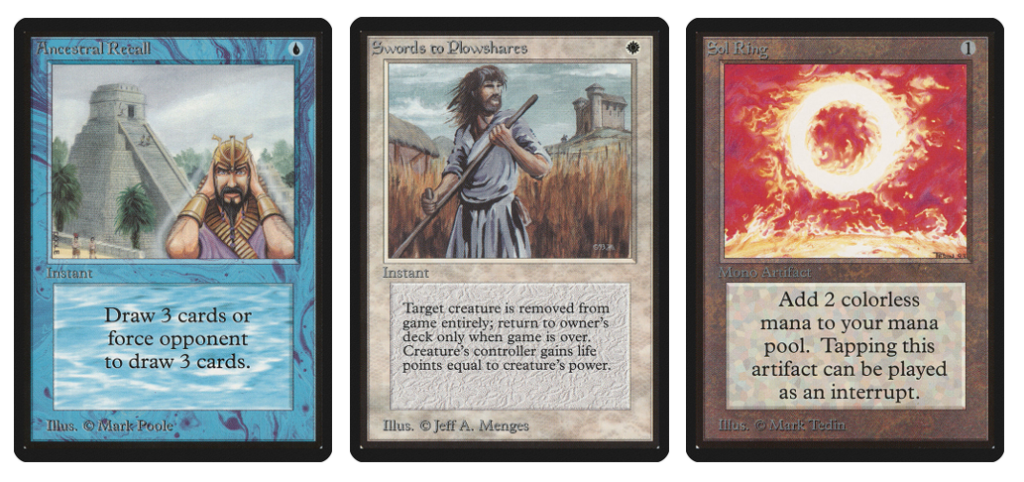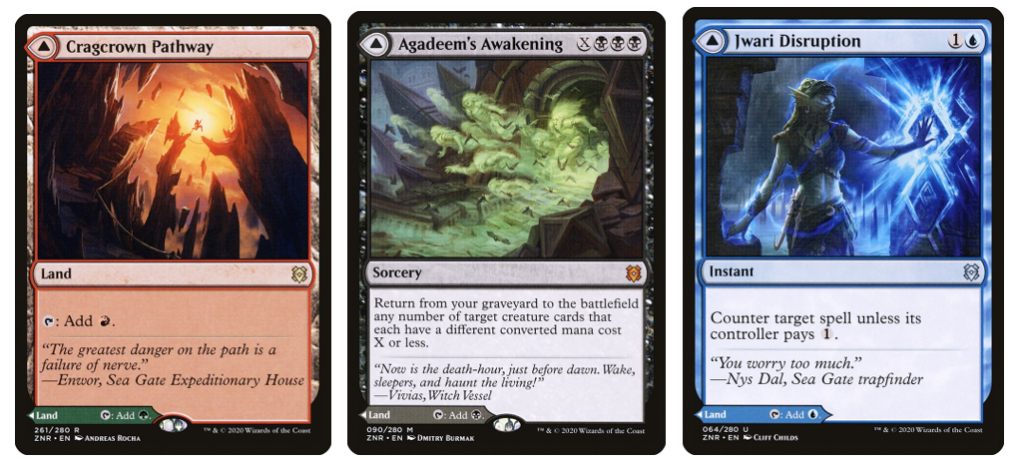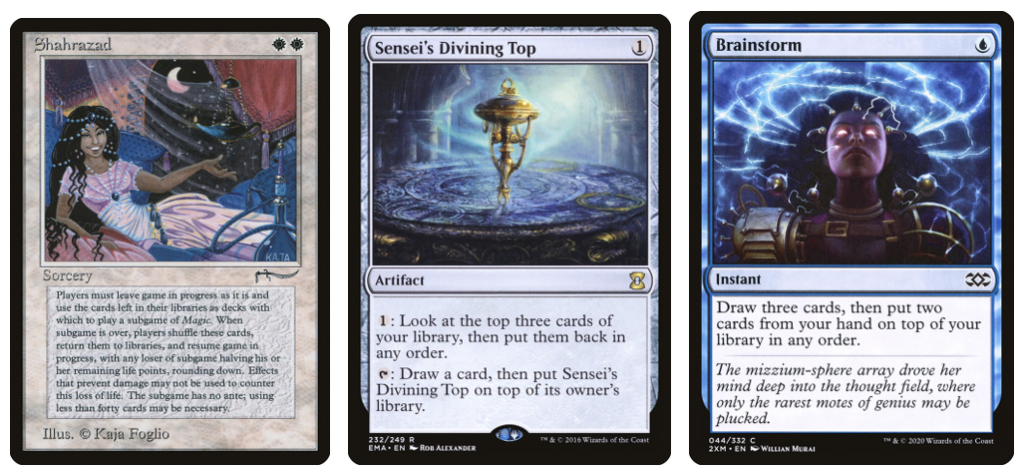Do you think games of Magic might be getting too fast these days? It’s an odd thing to worry about in regard to a turn-based strategy game, even if chess clocks and Arena ropes force us into hasty decisions from time to time. But in its own best measure of speed — how many turns it takes to crush opponents — faster games seem to be a compounding, genuine trend.
In eternal formats like Modern and Legacy, this power creep is mostly expected, because every new card added has a chance of unlocking some niche but powerful synergies within the larger card pool. But lately, even Standard has sped up as power creep and changing philosophies at WotC position game-defining threats at the three-CMC mark. What kind of impact does this have on gameplay? And is it even possible to put this efreet back in the bottle?
RECALLING THE ANCESTORS
One fact that is often lost in many modern discussions around balance and design is that Magic’s “game engine” of core rules was developed for a much slower game than we have today. There’s many reasons why 1994 games tended to be lengthy affairs. Limited Edition Alpha was without much color fixing or cantrips to smooth draws. Land destruction and discard were the strongest and most common they’ve ever been, making it easy to cut players off from their spellcasting resources.
This probably sounds pretty horrible, but missing a few turns of spellcasting was just not as big a risk as it is in the modern game. Alpha had few game-winning combos, and while creature stats were subpar by modern standards, the removal of the day was incredibly powerful. We still play Swords to Plowshares in Legacy today, but not Serra Angel or Time Elemental!

It’s very telling that the majority of other spells we still use from Alpha are ones that manipulate a player’s resources. The numbers on Ancestral Recall, Black Lotus, and Sol Ring may seem absurdly high, but at the time, they were mostly just used to cast mediocre monsters quickly. This all made it quite hard to close games in a hurry — which turns out to be very important.
A MODEST SLOW-PROSAL
Magic’s core rule set has held up remarkably well in the intervening decades, but I think everyone can agree that getting mana screwed or flooded is one of its major failings. In recent years, WotC has seemed determined to push back on this well-known flaw, changing the mulligan rules to be much more generous, and adding mechanics like Modal Double-Faced Cards to make more hands playable and avoid “non-games.”

But these mechanics, even when balanced, raise the ceiling on possible hands as much as they raise the floor. Linear decks abuse consistency tools to assemble winning combos faster than ever before. Another way to improve this mana screw/flood problem — and to reduce the impact of variance on games generally — is to stretch the average game over more turns.
This might seem counterintuitive; more turns means more draw steps, and draw steps are, of course, the main variable element in a game of Magic. But as you take more and more draw steps in a hypothetical game, the individual good and bad draws start to average out; the chance of extreme high- or low-rolls deciding the game outright actually decreases. Once you’ve seen enough cards for the “average” draw to include your key tools in the matchup, then you start to see player skill and deckbuilding choices decide the winner. And isn’t that what we all want from Constructed formats?
HOW TO HAVE A SLOW GAME IN 10 MINUTES
At this point, I should stop and make a very clear distinction: the difference between “slow” games of Magic and “long” games. Nobody wants to be bored at the feature match table, or for every game of Standard to last an hour. There’s a reason why Shahrazad and Sensei’s Divining Top are banned in Legacy!

When I say that I want Magic to be “slower,” I don’t mean in terms of real time. I mean that I want a game with more total turns, more “in-game” time between key decision points. Slowing the game down in this way doesn’t make it take longer to play; Legacy games feature fewer turns than Standard games on average, but both formats give you the same amount of time to play a tournament round.
By this definition, the Standard game is “slower” than the Legacy one — players aren’t making as many decisions per turn, and fewer of those decisions will be life-or-death. But neither game takes “longer” in real time. Both games contain a similar number of decisions per minute; the difference is whether more of those go into combat steps and main phase spells, or sequencing fetchlands and Brainstorms.
I see “impactful decisions per minute” as the #1 metric for identifying fun Magic; it’s a literal measure of agency, of hope. Land destruction and prison decks are disliked because they rob one player of these chances to act. But if both players are making fewer decisions per turn, that’s just a different flavor of fun. Draft has many loyal fans, and is often considered the most skill-testing Magic around, yet the average Draft game is definitely “slower” than Constructed in terms of decision-making.
DAMAGE DOESN’T WIN GAMES, CARDS WIN GAMES
Standard is slower than Modern, which is slower than Legacy. This broad truth is what sets Constructed formats apart, makes “format pillars” essential, and drives the logic behind bannings. But printing incredibly pushed threats at a cheaper cost than before has started to undermine this precious variety in several ways. The most obvious is decklist homogeneity; where before cards like Arcbound Ravager or Jace, the Mind Sculptor were iconic stars of a single format, now those different metagames revolve around many of the same cards.

But it’s not just that the usual suspects are showing up from Standard to Legacy — it’s how these cards are designed around generating resources. Every experienced player loves to remind their juniors that “the only life point that matters is your last one.” The reason that’s true is that losing life doesn’t put you in a weaker position in any other way; in fact, you tend to be in a temporarily stronger position because your opponent just tapped out to attack or cast spells at you. You can get beaten down to one life by a mono-green player and still have a shot at stabilizing, because you still get to assemble the resources to cast Doomskar.
This is why threats that draw cards for free — or generate free advantage by destroying, elking or preventing the use of opposing cards — are less forgiving than those that just deal damage. These threats absolutely snowball, putting you in a weaker and weaker position every turn that they’re alive. The card and life lead generated by Uro, Titan of Nature’s Wrath as it attacks matters far more than the six damage it might deal; even if you remove it, those resources stick around and make it harder to beat the next threat, and the next one, and the next after that. It’s just not feasible to let them do their thing for a few turns like you could with a Lovestruck Beast. All of these cards have to be killed on sight, and every Constructed metagame has started to feature more and more of them.
FAST THINGS START TO BLUR TOGETHER
Every extra draw step you give a player before they have to face a snowball threat like Uro or Oko is one more chance to find their outs. Each extra untap step makes it less important that they missed their third land drop for a turn, or played it tapped. But when these threats come down so early, and are so hard to effectively answer, we’re left playing a compressed version of Magic — one where players see fewer cards each game and make fewer meaningful plays, because the first play that goes wrong buries them.
This has a huge impact on which cards are considered viable for competitive play, forcing players to prioritize consistency above all else. Pushed cards overwhelmingly favor the guaranteed value of ETB triggers and static effects, mixed with abilities that generate “free” resource advantage with every turn they aren’t killed to snowball a lead. Planeswalkers, with their first “guaranteed” loyalty activation upon entering play and a natural mechanism for accruing value over time, are the poster child for this type of design.

The ubiquitous, guaranteed card advantage undermines the relevance of one-for-one removal, pushing designers to make it cheaper and more powerful to compensate. But this only creates a feedback loop where strong removal encourages even more reliance on value-based threats, since those still trade better than any other kind.
Eventually, this compounding effect makes the strategic landscape unrecognizable. There aren’t enough decision points in a game to differentiate between traditional archetypes like control, midrange, tempo or aggro. Instead, everything regresses toward a midrange soup of optimized threats, and perhaps the few all-in combo or aggro strategies quick enough to go under those threats.
This leads to more balance issues, because the margin of error for such linear decks to be fast and consistent (but not overpowered) is quite slim. We also get less interesting post-board games, since sideboard cards must lean heavily toward the most draconian and targeted options (think Leyline of the Void vs. Scavenging Ooze). These cards then simply become the new game-ending threats against all-in linear decks and bring the critical turn even earlier on the game clock. We’ve started to see this happen with an upsurge in decks like Neoform, Oops All Spells, Belcher, and now Tibalt’s Trickery raising hackles across different formats.
SETTING A HEALTHY PACE
Whatever speed of Magic you prefer, even if it’s the one we currently experience, I’m sure you don’t want it to become a game of tennis between two big servers, with all aces and no rallies. To slow down the game, the biggest thing we need from future card design is to make pushed threats more punishable — making sure they don’t refund their resources too reliably or snowball a lead beyond hope in a turn or two.
If we are going to print cards that are so decisive, let’s go back to having them be expensive planeswalkers. That way, there are more draw steps to account for variance before players have to worry about them, and even aggro decks can answer them in a timely fashion by sacrificing a turn of combat. Anything faster or more resilient than that should be reserved for older formats, where more explosive play is the norm and free countermagic can shield their worst excesses.
I’d bet that the majority of players can see the benefit in having clear differences between the speed of each Constructed format, because variety is the spice of life.

Tom’s fate was sealed in 7th grade when his friend lent him a pile of commons to play Magic. He quickly picked up Boros and Orzhov decks in Ravnica block and has remained a staunch white magician ever since. A fan of all Constructed formats, he enjoys studying the history of the tournament meta. He specializes in midrange decks, especially Death & Taxes and Martyr Proc. One day, he swears he will win an MCQ with Evershrike. Ask him how at @AWanderingBard, or watch him stream Magic at twitch.tv/TheWanderingBard.

